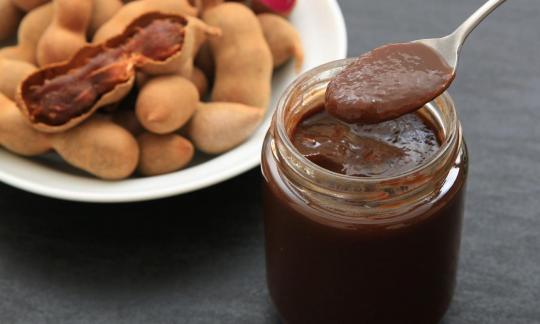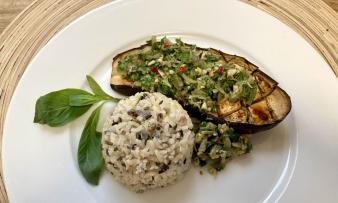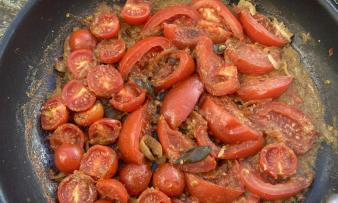Table of contents
Tamarind paste is a paste made from the pulp of the tamarind fruit and is raw depending on the production method. It is best used in organic quality, especially in Asian cuisine.
Use in the kitchen
Tamarinds are the fruits of the tamarind tree ( Tamarindus indica). In terms of taste, they can be divided into sweet and sour and very sour, with lighter fruits tending to taste a little sweeter than darker ones. In the kitchen, the pulp is mainly used, processed into a paste; mainly for seasoning chutneys, curries and sauces. It is also an integral part of the famous Worcestershire sauce from England. Mainly for Asian dishes, the paste is also used in African, Indian, Persian and South American cuisine, for both sweet and savory dishes.
In terms of taste, tamarind paste goes particularly well with spicy and fruity notes. It goes very well with mango or peaches in chutneys and with spices such as garlic, turmeric, ginger or chili in curries. Tamarind paste can also be used in dips, for example with mango, pineapple or green mint. Tamarind paste can also be used as a possible alternative to vinegar or lemon juice, although the taste is not entirely comparable. Last but not least, it can be used to refine exotic drinks and lemonades. In India, the pulp is eaten raw or sweetened with sugar. It is also used to make sweet dishes mixed with sugar, which are commonly called tamarind balls. Industrially, the pulp is usually used in India to make chilled drinks, jams, syrups and juices.
Homemade preparation
To make homemade tamarind paste, all you need is fresh tamarinds and water. For 2 people, you need 4 tamarinds and 4 teaspoons of hot water. First, remove the sticky tamarind mass from the pods with a teaspoon and put it in a small bowl. Then add the hot water and use a fork to combine the tamarinds with the water to form a mushy mass (similar to apple sauce). Depending on your preference, you can make the mass a little thicker or thinner by adding more water or more tamarinds. Finally, pass the paste through a tea strainer to sort out the seeds. Homemade tamarind paste will keep in the fridge for about 2 to 3 days.
Vegan recipe for vegetable curry with tamarind paste
Ingredients (for 4 people): 2 tbsp rapeseed oil (refined), 1 onion (finely chopped), 1 clove of garlic (finely chopped), 2 carrots, 2 bell peppers (red), 1 broccoli, 1 tsp ginger (grated), 1 tsp curry powder, 400 ml coconut milk, 200 ml vegetable stock, 2 tbsp tamarind paste (organic), 1 lime (juice and zest), salt andpepper.
Preparation: Heat the rapeseed oil in a large pot and sauté the onion until translucent. Add the garlic and ginger and sauté briefly. Add the curry powder and fry briefly. Add the coconut milk, vegetable stock and tamarind paste and mix well. Add the lime juice and zest and bring the sauce to the boil. Cut the vegetables into bite-sized pieces and add. Simmer the curry for around 15 minutes until the vegetables are cooked. Finally, season with salt and pepper. Serve the vegan vegetable curry with tamarind paste immediately. Basmati rice, for example, goes well with it.
Vegan recipe for fruit drink with tamarind paste
Ingredients (for 4 glasses of 300 ml each): 2 tablespoons tamarind paste (organic), 1.2 l drinking water, 1 piece of ginger (approx. 2 cm), 1 teaspoonvanilla powder, 3 tablespoons agave syrup.
Preparation: Put the tamarind paste and all the ingredients in a high-performance blender and puree until smooth. Then chill in the fridge for about 30 minutes and serve.
Vegan recipes with sour tamarind paste can be found under the note: " Recipes that have the most of this ingredient ".
| Not only vegans or vegetarians should read this: Vegans often eat unhealthily. Avoidable nutritional errors. |
Purchasing - Storage
You can find tamarind paste all year round in well-stocked supermarkets such as Coop, Rewe and Edeka. We are not aware of any large retailers such as Migros, Denner, Volg, Spar, Aldi, Lidl, Hofer or Billa offering it. Nor are they available in organic supermarkets such as Denn's Biomarkt and Alnatura. You may have a better chance of finding it in health food stores, online retailers, Asian shops or Indian specialty shops. If possible, look for organic quality.
Industrially produced tamarind pastes are often pasteurized and not raw. Organic pastes usually consist only of tamarinds and water. Conventional products can contain salt, sugar and other additives. are usually vegan, gluten-free and lactose-free, but to be sure, always read the ingredients list.
The availability of tamarind paste varies depending on the size of the store, catchment area, etc. Our recorded food prices for the DA-CH countries can be found above under the ingredient image - and by clicking you can see their development at various suppliers.
Storage tips
After opening, store tamarind paste in a cool, dry place, protected from light, in an airtight container.
Ingredients - Nutritional values - Calories
100 g of tamarind paste provides 106 kcal of energy. This consists mainly of carbohydrates (25 g/100g) and very little fat (0.2 g/100g) and protein (0.05 g/100g). 1
Manganese is present in 100 g of tamarind paste at 0.8 mg (40% of the daily requirement). Cashew butter (0.82 mg/100g) and Miang Kham sauce (0.85 mg/100g) contain a similar amount. Manganese is widespread in plant-based foods, particularly in the germs and outer layers of grains, e.g. wheat germ (13 mg/100g) or pumpkin seeds (4.5 mg/100g). 1
The potassium content is 456 mg/100g. This covers 23% of the daily requirement. Tahini (459 mg/100g) and Laksa curry paste (500 mg/100g) have similar amounts. Good sources of potassium are pulses and nuts, such as almonds (733 mg/100g) andchickpeas (718 mg/100g). 1
100 g of tamarind paste contains 74 mg of magnesium (20% of the daily requirement). Soy sauce (shoyu) contains the same amount of magnesium. Laksa curry paste contains similarly high amounts (69 mg/100g). Seeds and nuts such as hemp seeds (700 mg/100g) and linseed (390 mg/100g) are particularly high in magnesium. 1
Tamarind paste also contains fruit acid (especially tartaric acid, malic acid and citric acid), invert sugar, pectins, pyrazines and thiazoles (fragrances). 7 The pulp of the tamarind contains secondary plant substances such as flavonoids and tannins (vegetable tannins). 2
The complete ingredients of tamarind paste, the coverage of the daily requirement and comparison values with other ingredients can be found in our nutrient tables. In the article Nutrients explained you will get a detailed insight into the topic.
Health effects
Regarding the pulp of T. indica, human studies showed a significant reduction in total cholesterol and LDL cholesterol levels when consuming 15 mg/kg of dried and powdered pulp. Although the fruits had no noticeable effect on body weight and systolic blood pressure, they did lead to a significant reduction in diastolic pressure (residual pressure in the heart during relaxation phase). 3 In another study with 40 obese and overweight people, the consumption of 20 g of tamarind pulp per day showed a significant reduction in body mass index, blood pressure, LDL cholesterol levels and waist circumference within the intervention group, but no significant differences compared to the control group. 4
As a component of a facial lotion, fruit pulp extracts helped to lighten areas of the skin on the face (reducing the melanin level), without damaging the skin. 5
Consumption of tamarind also appears to have a positive effect on the mobilization of deposited fluoride in the bones by increasing fluoride excretion via urine. 6
Furthermore, there may be relief from metabolic syndrome and arteriosclerotic changes in combination with a disorder of lipid metabolism. Positive effects on obesity are also possible, which can be attributed to the increased dopaminergic transmission, the regulation of lipid metabolism and decreasing leptin levels. 7
Dangers - Intolerances - Side effects
The flesh of the tamarind is generally considered harmless. 8 No side effects, interactions or contraindications are known. 7 If you are allergic to pulses, 9 allergic reactions may also be possible when consuming tamarind paste. In addition, people who are allergic to grass pollen can develop a cross allergy with pulses. 10
Since tamarind fruits and the pastes made from them contain high amounts of fructose and histamine, people with intolerance to fructose or histamine should be careful. However, only small amounts of the paste are usually used, so it should still be tolerable. 18
Tamarinds have a mild laxative effect 12, which is why you should not consume too much. However, if consumed within the normal amount, no side effects are to be expected.
Folk medicine - natural medicine
The use of Tamarindus indica is known primarily in ethnomedicine. The treatment covers a wide range of ailments. In addition to the pulp, the leaves and flowers, bark and seeds of the tree are also used. The individual components are said to have an anti-inflammatory effect and are used for joint pain, bronchial asthma, wound healing, eye diseases, colds, arthritis, blood clots, dysentery (inflammation of the intestine caused by bacteria), diarrhea, dental diseases and as an antidote. 11
The pulp of the tamarind is used, among other things, as a remedy for gallbladder problems and fevers, as a gentle laxative under the name "Pulpa tamarindorum", in combination with lime juice, honey, milk, dates, spices or camphor as a means of promoting digestion and against flatulence and to improve loss of appetite. It is used for sunstroke, Datura poisoning, against the intoxicating effects of alcohol and Cannabis sativa, as a gargle for sore throats, for dressing wounds, for healing malaria fever and as a rub for rheumatism. 12 In addition, the use of tamarind pulp is known in India for bilious vomiting, inflammation of the mouth and throat area and for hemorrhoids. 7
Ecological footprint - animal welfare
The CO 2 footprint is primarily used to assess the climate friendliness of a food. This depends on various factors. The type of agricultural production (conventional vs. organic), seasonal, regional or domestic production or import by truck, ship or plane, different types of packaging and whether the goods are fresh or frozen all play a decisive role. 13 Tamarind paste is calculated using a CO 2 footprint of 0.61 kg CO 2 eq/kg, although this value may vary depending on the manufacturer. 14
Despite intensive research, we have not yet been able to determine the water footprint.
You can read detailed explanations of various sustainability indicators such as ecological footprint, CO2 footprint or water footprint here.
Worldwide occurrence - cultivation
Tamarind paste is now sold worldwide. India is considered the largest producer of various products made from the tamarind fruit, e.g. concentrated pulp with seeds, pastes in cans, dried pods or in powder form. 15
Detailed information on the worldwide occurrence, cultivation and harvest of tamarind can be found in the article on the ingredient: Tamarind (raw, organic?).
Further information
The basis of tamarind paste is the pulp of the tamarind fruit. The tamarind tree ( Tamarindus indica) belongs to the legume family (Fabaceae).
Alternative names
In English, tamarind paste is called "tamarind paste".
Other uses
The pulp of the tamarind is used as a raw material for the manufacture of various industrial products such as tamarind juice concentrate, tamarind pulp powder, tartaric acid, pectin, tartarates and alcohol. 16 The pulp is also a good ingredient for the manufacture of skin care products such as soaps as it has skin lightening, toning and treatment properties. It is also used as a fixative in dyeing, eg with turmeric ( Curcuma longa) and annatto ( Bixa orellana). It is also used to coagulate rubber latex and to produce ethanol. 17
Bibliography - 18 Sources (Link to the evidence)
| 1. | ÖNWT Österreichische Nährwerttabelle. |
| 2. | Rana M, Sharma P. Proximate and phytochemical screening of the seed and pulp of Tamarind indica. Journal of Medicinal Plants Studies. 2018;6(2):111–115. |
| 3. | Iftekhar AS, Rayhan I, Quadir MA, Akhteruzzaman S, Hasnat A. Effect of Tamarindus indica fruits on blood pressure and lipid-profile in human model: an in vivo approach. Pak J Pharm Sci. 2006;19(2):125–129. |
| 4. | Asgary S, Soltani R, Barzegar N, Sarrafzadegan N. Evaluation on the Effects of Tamarindus Indica L. Fruit on Body Weight and Several Cardiometabolic Risk Factors in Obese and Overweight Adult Patients: A Randomized Controlled Clinical Trial. Int J Prev Med. 2020;11:24. |
| 5. | Maenthaisong R, Chaiyakunapruk N, Warnnissorn P, Viyoch J. Cleansing lotion containing tamarind fruit pulp extract. III. Study of lightening efficacy and skin irritation on Asian skin type. Science Asia. 2009; 35(1):24–30. |
| 6. | Khandare AL, Kumar P U, Shanker RG, Venkaiah K, Lakshmaiah N. Additional beneficial effect of tama-rind ingestion over defluoridated water supply to adolescent boys in a fluorotic area. Nutrition. 2004; 20(5):433–436. |
| 7. | Bäumler S. Heilpflanzenpraxis Heute - Arzneipflanzenporträts (3. Auflage). Urban & Fischer: München; 2021. |
| 8. | Komakech R, Kim Y goo, Matsabisa GM, Kang Y. Anti-inflammatory and analgesic potential of Tamarindus indica Linn. (Fabaceae): a narrative review. Integrative Medicine Research. 2019;8(3):181–186. |
| 9. | Gesundu Gesundheitsportal. Martens F, Dötzer G. Allergie auf Nahrungsmittel. 2019. |
| 10. | DEBInet Deutsches Ernährungsberatungs- & Informationsnetz. Nahrungsmittelallergien - Pollen. |
| 11. | Maruga Raja M, Poonguzhali S, Rao BV, Choudhury A, Devarajan A. A scientific evidence-based review of tamarind usage in indian folklore medicine. JNR. 2022;347–362. |
| 12. | El-Siddig K, Gunasena HPM, Prasad BA, Pushpakumara DKNG, Ramana KVR, Vijayanand P, Williams JT. Fruits for the Future 1 (Revised edition): Tamarind, Tamarindus indica L. Southampton, UK: Southampton Centre for Underutilised Crops; 2006. |
| 13. | Reinhardt G, Gärtner S, Wagner T. Ökologische Fussabdrücke von Lebensmitteln und Gerichten in Deutschland. IFEU Institut für Energie- und Umweltforschung Heidelberg. 2020:1–22. |
| 14. | Carbon cloud com: Tamarind paste. |
| 15. | Polaris Market Research com: Tamarind Extract Market Share, Size, Trends, Industry Analysis Report, By Form (Paste and Powder); By Application; By Distribution; By Region; Segment Forecast, 2023-2032. |
| 16. | Bhadoriya SS, Ganeshpurkar A, Narwaria J, Rai G, Jain AP. Tamarindus indica: Extent of explored potential. Pharmacogn Rev. 2011;5(9):73–81. |
| 17. | Chimsah FA, Nyarko G, Abubakari AH. A review of explored uses and study of nutritional potential of tamarind (Tamarindus indica L.) in Northern Ghana. African Journal of Food Science. 2020;14(9):285–294. |
| 18. | Unvertraeglichkeitsladen de: Cosmoveda Tamarindenpaste Bio. |











Comments